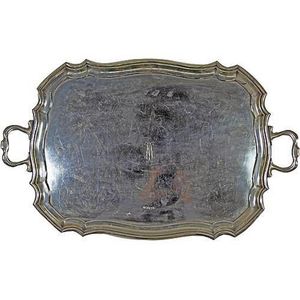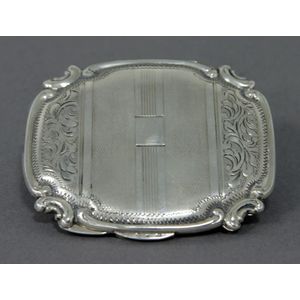WMF Art Nouveau Silver Plated Tray, Circa 1910
You must be a subscriber, and be logged in to view price and dealer details.
Subscribe Now to view actual auction price for this item
When you subscribe, you have the option of setting the currency in which to display prices to $Au, $US, $NZ or Stg.
- Jugendstil - The German and Austrian version of the Art Nouveau style and the other related styles that were expanding everywhere in Europe in the early 20th century.
The name was derived from the title of the Munich cultural magazine, "Die Jugend", with the addition of "Stil", which translates as "youth style".
Jugendstil encompasses all forms of architecture and art: industrial facilities, elevated-train systems, villas, churches, as well as the interior design of bars and coffee houses
In Austria, Jugendstil developed also in various ways, mainly under the effect of the Viennese Secession and of the Wiener Werkstätte. - Circa - A Latin term meaning 'about', often used in the antique trade to give an approximate date for the piece, usually considered to be five years on either side of the circa year. Thus, circa 1900 means the piece was made about 1900, probably between 1895 and 1905. The expression is sometimes abbreviated to c.1900.
- Art Nouveau Period - The Art Nouveau period was a cultural movement that emerged in the late 19th century, and was characterized by its emphasis on natural forms, flowing lines, and a decorative, ornamental style. Art Nouveau was a reaction against the ornate and heavily stylized designs of the previous era, and sought to create a new, more organic aesthetic.
Art Nouveau was characterized by its use of sinuous, curving lines, as well as a focus on natural elements such as flowers, vines, and other organic shapes. Art Nouveau designers sought to create a total work of art, in which every element of a building or object was designed to be harmonious with the overall design.
Some of the most iconic examples of Art Nouveau design include the Paris Metro entrances designed by Hector Guimard, the works of the artist Alphonse Mucha, and the architecture of Victor Horta in Brussels.
The Art Nouveau period was at its peak between 1890 and 1910, but began to decline in popularity by the start of World War I. However, Art Nouveau remains an important influence on design and art to this day, and continues to be celebrated for its emphasis on natural forms and decorative style.
This item has been included into following indexes:
Visually similar items

English hallmarked sterling silver Edward VIII double handled tray of shield form, with inscribed monogram 'Wn'. Sheffield, 1936, maker Hardy Brothers length 62 cm weight 2706g

Sterling silver photo frame, marked 925. 18 cm x 14 cm (outside measurements).

An early 20th century French silver powder compact with ornate scroll edging, chased floral decoration and engine turned panels, marks on thumb catch 835. Width 95 cm

Austro-Hungarian silver tray 800/1000 purity, 60 cm high, 1480 grams
